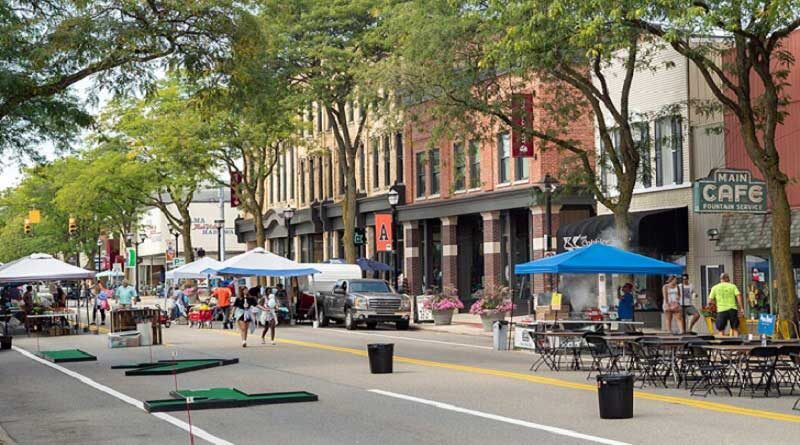Alma Aspires: A Small Town Showcases Its Successes

By Dianna Stampfler
It’s a cooperative attitude along with a charming and vibrant historic downtown that make Alma the ideal backdrop for Michigan State University Extension’s Connecting Entrepreneurial Communities (CEC) conference, September 14-15.
“Over the past decade, Alma has seen significant growth in its downtown area,” says Jim Wheeler II, President of Greater Gratiot Development Inc., and one of six “Alma Aspires” Keynote panelists for the CEC. “New projects include several second story housing projects, multiple restaurants including a brewery and e-gaming sports lounge, a boutique hotel, and the Wright Opera House Block which offers retail/restaurant space, large event space, and student housing for Alma College. These projects have been successful due to collaboration among local city officials, local and state economic development staff and visionary developers. We hope [CEC conference] attendees will get inspired by this theme of collaboration and take ideas back to their own cities.”
Incorporated as a village in 1872 (with a population of a mere 425) and a city in 1905, Alma is now the largest community in Gratiot County with just under 9,000 residents according to the 2020 census. The Alma Downtown Historic District, featuring 72 mostly brick commercial structures spread out over 11 city blocks, is recognized by both the Michigan and National Historic Registers (established in 1975 and 2013, respectively).
Over Memorial Day weekend, the Alma region swells thanks to one of Michigan’s top annual celebrations – the Alma Highland Festival and Games. First held in 1968 in what is called “Scottland USA,” this event draws clans and fans from around the Midwest for the U.S. Open Pipe Band Championship, Highland Dancing Competition, heavyweight athletic events, Border Collie Exhibition, reenactment camp, arts & crafts show, Scottish food, kilts, bagpipes and so much more.
The longest operating entity in town is Alma College (home of the plaid-wearing Scots), founded in 1886 as a small liberal-arts institution with a current enrollment of about 1,400. Students can select from 45 different undergraduate programs, majoring in everything from Game Design and Environmental Studies to Sports Communication and Pre Law. Two graduate programs – Creative Writing and Communication & Information Technology – are also available. Outside of the classroom, there are nearly 100 student organizations which are meant to spark social engagement, personal growth and community involvement.
“Alma College’s partnership with our county and city communities has been the economic backbone of this region since the college’s founding, and one key reason for that success has been our faculty, staff and student body,” says Jeff Abernathy, College President and “Alma Aspires” panelist. “In recent years, we have engaged them in supporting this community through a number of initiatives, such as the Center for College and Community Engagement. With a focus on sustainability and purpose, our students have worked with virtually every aspect of our local communities on meaningful service opportunities. We have partnered with MidMichigan Medical Center-Gratiot, which allows students in our Bachelor of Science in Nursing program to use their simulation lab for hands-on training. Students in our popular education program receive valuable experience in the field by working with our local school districts. Our PlaidWorks Micro-Internship Program benefits the nonprofit sector. The list goes on and on.”
Overcoming challenges and redefining priorities based on environmental, social and even political shifts are key to any community’s sustainability and growth. In Alma, there is a conscious effort to work together in tackling these issues for the betterment of the region.
“Living up to our potential — both as a college and as a rural community — requires collaboration,” says Abernathy. “This has never been more apparent than over the past two years, when we faced unprecedented challenges brought on by COVID-19 and an economic recession. We were able to weather these storms, I believe, in large part due to the collaborative planning that had been undertaken in 2019 with the ‘Alma Aspires’ plan and the steadfast determination it took to see that plan through — helping Alma stay on the path to becoming the best small city in Michigan.”
Decades before the pandemic, Alma was forced to change course and look at new economic and employment streams in order to survive and thrive.
“In the late ‘90s, Alma suffered a significant setback when one of its major industries withdrew from the area, taking a number of skilled and devoted community members with it,” says Wheeler. “Since then, the community has worked together to diversify the city’s economy, increase the quality of life and plan for future opportunities. We are now seeing positive results from this hard work, and we hope it is apparent to our guests during CEC as well.”
The “Alma Aspires” strategic vision goes beyond the city limits, drawing support and energy from throughout Gratiot County for the betterment of the mid-Michigan region.
“In 2010, Gratiot County and numerous townships all passed a countywide model wind energy ordinance, which allowed for large wind farm projects to cross township boundaries without adhering to a different set of rules,” Wheeler says. “As a result, 11 of the 16 townships now have wind farm projects that significantly increase the area’s tax base. Over $1 billion has been invested in Gratiot County from wind energy.”
While there are a vast number of other areas where these collaborative initiatives are operating, a Countywide Master Plan allows cities, villages and townships to focus on similar goals and strategies when it comes to zoning endeavors.
“This shows that the area is on the same page when it comes to development,” says Wheeler. “Additionally, the municipalities in the area have worked together numerous times to provide new or upgraded services to increase the quality of life in Gratiot County, including the Gratiot Area Water Authority, the St. Louis, Ithaca, Pine River, and Alma Transportation Authority, several countywide millages, a countywide Chamber of Commerce, and numerous other initiatives. The leaders in Gratiot County understand that collaboration is necessary for growth.”
Beyond the world of governmental agencies and municipalities, Alma and the Gratiot County remain vested in programs that support the current business community as well as inspire and engage future generations. Among the sessions at the CEC conference are “The What, Why and How of Youth Entrepreneurship” and “Building New Leaders” meant to cater to millennials and zoomers and those who work with these younger employees and volunteers.
“What we tell students is that we want them to think critically, serve generously, lead purposefully and live responsibly as stewards of the world they bequeath to future generations,” Abernathy says. “For every visitor who comes to Alma and Gratiot County, we hope we’re able to inspire them to do the same.”
Dianna Stampfler has been writing professionally since high school. She is the president of Promote Michigan and the author of Michigan’s Haunted Lighthouses and Death & Lighthouses on the Great Lakes, both from The History Press.

